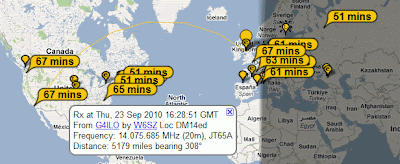 JT65 on HF
JT65 on HF
Several of my blogging compadres have written recently about using the JT65-HF software by W6CQZ so I thought I would give it another try to see if I could understand what all the fuss is about. This is not the first time I have tried the program. I tried it at the beginning of the year. In fact, it was the main reason for upgrading my shack computer because the old one could not decode the received signals quickly enough to give me time to reply to calls. But having got the new PC I found the mode rather uninvolving as contacts are made just by clicking buttons to send computer-determined reports and you can’t even tell which of the signals you can hear is the one you are replying to.
I decided to run the K3 at 5W into the dipole because the K2 was doing 30m APRS gateway duty on the magnetic loop and the two antennas are only a few feet apart. But there was no interference. I’m not sure how much power people normally use on this mode but I might try more next time. My new shack computer coped easily, decoding the received JT65A signals in a second or so despite the fact that it was simultaneously running two APRS gateways one of which was using TrueTTY and a USB sound card to decode the packet data.
I found a free spot on the waterfall, sent a CQ and two people immediately came back to me at the same time. I didn’t decode anything! I called again and this time three people replied! I sent CQ once more and this time the first two must have decided I was either deaf or an idiot which left just one signal on my frequency: OE1LIC, for my first contact of the day. My second CQ raised RZ6AUJ, Alex for another contact and that was all I had time for before dinner.
One of the features of JT65-HF is that it automatically links in to the PSK Reporter network so you can see all the stations you heard on a map and, even more interestingly, all those that heard you. I remembered this and popped up to the shack after dinner to grab a screen shot. As you can see, my 5W to an attic dipole was heard by two stations on the west coast of the USA, and I was only on the air for about 20 minutes! The small blob on the west coast is VE7IRA who was heard by me despite the appalling S9 interference I get on this band, which was reduced to about an S3 by the MFJ-1026 noise canceller using a PA0RDT mini-whip for a noise antenna.
I still find using JT65A on HF feels a bit odd but I can understand why it has become so popular, even addictive. It takes up little band space and doesn’t interfere with other band users unlike a certain R** digital mode. I said this before and didn’t end up doing it but I think I will spend a bit more time using JT65-HF to see what I can work and whether I can join the crowd of enthusiasts for this unusual digital mode.















